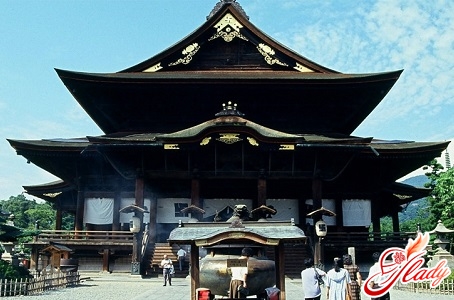
Japan, being a small islandstate, has great economic potential and rich cultural heritage. It is amazing how generously nature has endowed this region, while the geographical location allows you to observe the change of all four seasons. Historical monuments and modern technical achievements coexist in a wonderful country. The sights of Japan are diverse and extremely interesting, and every year you can see an endless stream of tourists and travelers wishing to visit this country.

Historical monuments of Japan
Interesting places in Japan are so diverseand numerous, that for a visual oral review it will be better to make a conditional division. For lovers of antiquity and exquisite style, a visit to Himeji Castle, located at the foot of the picturesque Mount Hime in Hyogo Prefecture, is recommended. This structure is an echo of the samurai era, which was listed by UNESCO in 1993 as a World Heritage Site. It was built in the 14th century and withstood numerous battles for two centuries. When the building passed into the hands of the military leader Hideyoshi Toyotomi, there was practically nothing left except the walls. In the period 1601-1609, the castle was reconstructed, as a result of which an elegant tower consisting of seven tiers appeared, and in addition, a whole cluster of auxiliary towers. It can be noted that the building was designed to protect against a possible attack: observation can be carried out from high-rise objects, and the adjacent garden is divided into complex labyrinthine paths with dead ends. Another similar monument, located in Nagano Prefecture, is called Matsumotojo (Matsumoto Castle). The structure was erected during the Sengoku era, it has a five-tiered main tower and side high-rise elements spread out like wings. It is noteworthy that the entire building is painted black and the shape of the building creates the impression of a soaring bird, which is why this rare object is also called the "Crow Castle". At the same time, part of the building is called the "Moon Chambers", since it was customary to observe the movement of this celestial body here. And, of course, one cannot fail to note the Tokyo Imperial Palace as a monument of Japanese history and culture. This structure was created over several centuries, it underwent changes with the change of power and political directions in the country. The Emperor's residence has an area of about 7,000 m , while part of the building is made taking into account the tradition of the people, and the other - according to the canons of European architecture. The adjacent area is decorated with beautiful gardens, in addition, there is a Museum of the Emperor's collections and a treasury with attributes of power.
Religious sights of Japan
Among the monuments of religious significanceOf particular interest is the Mausoleum of Confucius located in the city of Nagasaki. This temple was built by the architects of the Great Celestial Empire, and the land on which the structure stands still belongs to this country. The mausoleum was erected for the purpose of education, where the basics of Confucianism were taught. In the background is now the Museum of Chinese History, also exhibited here are various models of inventions of the Celestial Empire and maps depicting the trajectory of the Great Silk Road. The outer walls are decorated with statues symbolizing the followers of Confucius. In Japan, there are and are still operating today temples of various religious denominations. For example, the Zenkoji Temple, at the base of which the famous city of Nagano grew, belongs to the Buddhist schools of Jodoshu and Tendai. Here, worship is performed before the sculpture of the Great Buddha, this relic is shown even to the monastery servants themselves once every 7 years. The structure itself consists of several buildings, which are located along the cardinal directions. The main gate and the prayer hall are listed as National Treasures of Japan. Kinkakuji Temple - "Golden Pavilion" - is a building that belonged to the Rinzai school of Zen. This building is used as a repository for the holy relics of Buddha. The temple is beautifully decorated with a "golden interior", and from the pavilion itself you can see the islands in the adjacent lake. Among the monuments of Shinto significance, one can note the Meiji Jingu Shrine. This is the largest building of this school, located in the capital prefecture. This shrine was built in honor of Emperor Meiji and his wife in the unique Nagarezukuri style of architecture, where cypress wood is used. The building is surrounded by a magnificent garden created by ordinary people from all over the country in memory of their beloved leader. More than 100,000 species of plants (bushes and trees) are planted here, and there is also a treasure museum built in the Azekura-zukuri style on the temple grounds.
Natural places of interest
Mount Fuji is particularly popularplace among the Japanese. The local population has a saying that literally translates as follows: "Never to climb to the top is stupid, and to climb it twice is stupid." This expression can be explained as follows: someone who has not had the chance to climb Fujiyama or who is afraid to do so, misses out on a lot. And a person who has already been lucky enough to visit the top is constantly drawn here again and again, and this is already considered stupid. The height of this natural masterpiece, created as a result of the eruption of volcanic rocks, is about 4,000 km. The season for climbing the mountain is July-August, when there is the least accumulation of fog and the weather is generally favorable for climbing. At the top, the air is thin, but clean, and the temperature does not rise above 10 ° C, so when climbing the mountain, it is better to stock up on warm clothes. There are many large parks in Japan, such as Ueno, Koraku-en, Kenroku-en and Kairaku-en, with the last three considered the most famous gardens, which are created according to the ideal principles of natural landscape. The love of the local population for such places is explained by their traditions, which are based on tribute to the living environment. The Japanese have such beautiful customs of watching the cherry blossoms - Hanami and the autumn festival Momiji, when people gather in parks to look at the colorful carpet of leaves. Also famous is the botanical park in Hiroshima, where numerous exotic plants are presented in natural conditions. And the olive tree garden Ushimado is one of the largest reserves, where more than 2000 specimens grow. The sights of Japan are so numerous and interesting, so it is not surprising that the flow of tourists and travelers in this direction does not decrease. As statistics have shown, every person who has visited the Land of the Rising Sun at least once, comes here again at least once in his life.









